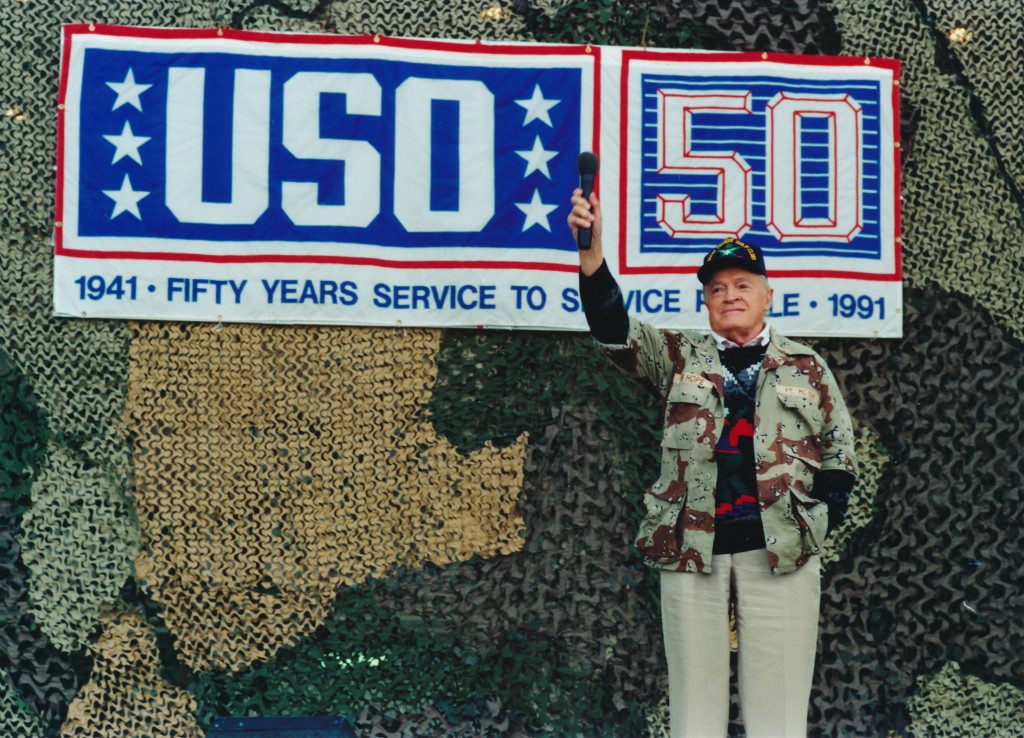Bob Hope was not the greatest golfer who has ever played the game, but he might have been the most enthusiastic. As he traversed the globe entertaining both black-tie audiences and battalions of scruffy soldiers, Hope became one of the game’s greatest ambassadors. He made a second career of teeing it up with Presidents, Princes and the King – in fact; he teamed up with fellow World Golf Hall of Fame member Arnold Palmer to win the pro-am portion of the Palm Springs Desert Classic in 1962.
Three years later, Hope took the reins of that tournament and it bore his name for more than four decades. Whether it is in Bob Hope Square on the tournament grounds, the Bob Hope Legacy Pro-Am before the event or the trophy that still bears his likeness, his legacy is still a vibrant part of the CareerBuilder golf tournament.
But what cemented Hope as one of the country’s most beloved entertainers were his USO Tours. He first began performing for the troops in 1939, a full two years before the United States’ entry into World War II. For more than 50 years, he would entertain troops all over the world in the midst of World War II, the Korean War, Vietnam and the Persian Gulf War.
When Hope was not making a film or on a USO Tour, you could always find him on a golf course. Palmer and Hope introduced the game to millions of Americans; Palmer through dramatic victories, Hope through the power of laughter. In one year, Hope played in 150 charity golf events, smiling the whole way through. He played in the first ever CareerBuilder event (then the Palm Springs Desert Classic) in 1960.
When Hope agreed to become a permanent part of the tournament in 1965, it was a marriage made in a place some call heaven: a celebrity and a golf tournament in a gorgeous location, working together to raise awareness for the game and millions of dollars for charity. Eventually this partnership would result in the construction of a new hospital, which became the Eisenhower Medical Center in Rancho Mirage.
With Hope’s name on the tournament, the money raised by the event increased dramatically. During first year, they were able to double the amount of money received for the TV rights to $100,000 per year. The Hope name also brought a new array of stars who wanted to play in the Bob Hope Classic – and even to perform at the Bob Hope Classic Ball – which preceded the event.
With the support of Hope and his wife, Dolores, the tournament began to raise significant funds. A good portion of that money was dedicated for the Eisenhower Medical Center, which some in the Coachella Valley call “the hospital that golf built.” Hope served as Master of Ceremonies at the groundbreaking in 1969, which was partially enabled by the Hope’s donating 80 acres of land for the hospital campus.
With the Hope’s fully embracing the tournament and the mission of the hospital, they helped raise more than $52 million for charity, the majority going to the hospital. Through her leadership, Dolores spent more than 40 years on the board of trustees, many of them as president.
The success of the golf tournament led to one of Hope’s most memorable honors. In 1983, he was inducted into the World Golf Hall of Fame. In November 2008, the Hall of Fame honored Hope by opening the “Bob Hope: Shanks for the Memory” exhibition. Still on display today at the Museum in St. Augustine, Florida, the exhibition features rare memorabilia, photography, stories, audio tour recordings and video. Guests can trace Hope’s life from his immigration from England as a young child through his rise to the top of Hollywood. Covering more than 3,000 square feet, the exhibition also looks at his devotion to U.S. troops, his relationships with U.S. Presidents, and of course the Bob Hope Classic.
Thanks to the popularity of the exhibition in St. Augustine, the Hall of Fame, with support from the Bob & Dolores Hope Foundation, was able to create a second exhibition in 2011 that is able to travel to other museums called “Bob Hope: An American Treasure.” This exhibit shares many of the same stories as the exhibit inside the Hall and utilizes unique artifacts, vintage photography and video as well as hilarious sound bites.
Since the exhibition was created, it has had a travel schedule that Hope himself would admire, starting at the Green Bay Packers Hall of Fame at historic Lambeau Field, the Gerald Ford Presidential Museum in Grand Rapids, Michigan, the Greenwich Heritage Centre in London during the 2012 Summer Olympic Games, the Palm Springs Air Museum, Midland County Public Library in Midland, Texas, the National World War II Museum in New Orleans, aboard the Queen Mary in Long Beach, The National Museum of the Pacific War in Fredericksburg, Texas, and is currently on display at the Wings Over the Rockies Museum in Denver, Colorado.
Both Bob and Dolores have now passed, but their accomplishments will continue to live on. They amassed many honors, degrees and citations in their lifetimes. Without the Hope’s, there might not be a major golf event held annually in the Coachella Valley; Eisenhower Medical Center might not have been built; thousands of children might not have had great programs to help lead productive lives, and thousands more might have had to suffer homelessness, hunger and ill health.
Hope’s love of the game clearly endures, and he is still making people smile.


